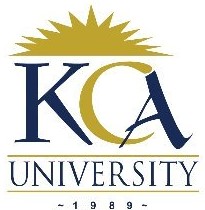
UNIVERSITY EXAMINATIONS: 2017/2018
ORDINARY EXAMINATION FOR THE DIPLOMA IN
INFORMATION TECHNOLOGY
DIT 501: FUNDAMENTAL OF ORGANIZATIONAL
MANAGEMENT
FULLTIME/PARTIME
DATE: APRIL, 2018 TIME: 1½HOURS
INSTRUCTIONS: Answer Any THREE Questions.
QUESTION ONE
a) Elaborate on the organizational environment focusing on both internal and external
environment (10 Marks)
b) Using a diagram apply Abraham Maslow theory of motivation to explain the levels of needs
and their influence towards achieving organizational goals. (10 Marks)
QUESTION TWO
(a) Discuss three skills that a manager of an organization need to acquire in order to ensure that
the organization achieve its objectives.Use examples where necessary (6 Marks)
(b) Giving examples, distinguish four differences between a manager and a leader
(4 Marks)
(c) Define the term planning and highlight any 4 importance of planning in an organization
(5 Marks)
(d) Define the following terms as used in management
(5 Marks)
i. Organizing
ii. Delegating
iii. Responsibility
iv. Authority
v. Power
QUESTION THREE
(a) Highlight any 3 distinguishing features between human resource management and
personnel management (6 Marks)
(b) Discuss any 4 reasons for workers’ to claim for wage increase in an organization
(4 Marks)
(c) Productivity is a critical aspect in the modern firms, explain how the use of IT techniques
can aid in enhancing productivity in our organizations. (10 Marks)
QUESTION FOUR
a) Explain the characteristics of a good objective for an organization of your choice
(10 Marks)
b) Explain the following management functions:
– Planning (2 Marks)
– Controlling (2 Marks)
– Staffing (2 Marks)
D) Discuss FOUR factors that hinder effective goal setting (4 Marks)
QUESTION FIVE
a) Explain the various basis in which the organization chart can be developed and structured.
(10 Marks)
b) What is the effect of culture on the management and performance of an organization, briefly
discuss FIVE ways. (5 Marks)
c) Using a diagram, eleaborate on the various levels of management. (5 Marks)
